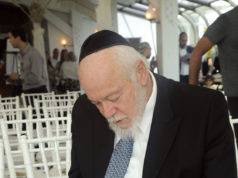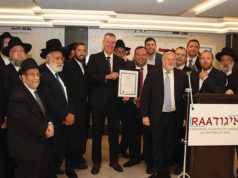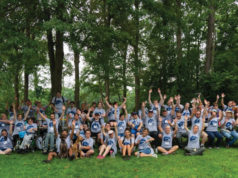
The history of the Jews in Australia began with the transportation of several Jewish convicts aboard the First Fleet in 1788, when the first European settlement was established on the continent in present-day Sydney. Today, an estimated 120,000 Jews reside in Australia, the majority being Ashkenazi Jews of Eastern European descent. Many are refugees and Holocaust survivors who arrived during and after World War II.
The Jewish population has been swelled more recently by immigrants from South Africa and the former Soviet Union. The largest Jewish community in Australia is in Melbourne with about 60,000, followed closely by Sydney with 45,000 members. Smaller communities are dispersed among the remaining cities.
Since the days of British colonialism, Jews have enjoyed formal equality before the law in Australia and have not been subject to any form of state sponsored anti-Semitism, which would exclude them from full participation in public life.
They assisted in the development of the country and were particularly prominent in the raising of sheep and cattle. In science, art, and literature, Jews have been active contributors. A number have even held prominent public government office.
European settlement began in 1788 and the earliest Jewish community came about almost 100 years later. Sydney, the capital of the mother-colony of New South Wales, contains the oldest Hebrew congregation. There were about 20 Jews in the colony in 1817.

Nevertheless, they were sufficiently attached to their religion to form themselves into a Jewish burial society. In 1820 the Jews obtained their own bet chayyim (burial ground) by applying to the Rev. Dr. Cowper, who allotted to them the right-hand corner of the Christian cemetery. The death of one Joel Joseph prompted the application; and he was the first Jew buried there. During the next 10 years there was no great increase in membership; and the services of the society were not called for more than once a year.
In 1827 and 1828 the worldly condition of the Hebrews in the colony improved considerably, in consequence of the great influx of respectable merchants; and this, with other circumstances, raised the Hebrews in the estimation of their fellow colonists. About this period Mr. P. J. Cohen offered the use of his house for the purpose of divine worship, which was performed for the first time in the colony and was continued regularly every Sabbath and holiday.
Divine service was also performed occasionally in a room hired by A. Elias and James Simmons. Everything in connection with their religion remained in this condition until the arrival of Aaron Levi, in the year 1830. He succeeded in instilling, into the minds of the congregation, a taste for the religion of their fathers. A Sefer Torah was purchased, divine service was more regularly conducted, and from it, established Jewish religion in Sydney. In 1832 they formed a proper congregation, and appointed J. B. Montefiore as the first president.
In the same year, the first Jewish marriage was celebrated between Moses Joseph and Miss Nathan. Three years later, a Mr. Rose came from England and acted as the chazzan, shochet, and mohel. He was succeeded by Jacob Isaacs. The condition of the Jews improved to such an extent that in 1844 they erected their first synagogue in York Street, Sydney, in which they continued to worship for more than 30 years.
Tasmania was most likely the second Jewish settlement in Australia. The oldest surviving synagogue on the continent is the Hobart Hebrew Congregation Synagogue. It was consecrated on July 4, 1845. Jews also began to assemble in Victoria in the 1840s and congregations sprang up in Melbourne, where in 1847 the first synagogue opened. This was followed by St. Kilda, Geelong, Bendigo, and Ballarat (1853).

By the 1850s, during the time of the Victorian Gold Rush, Melbourne had become the largest Jewish settlement in the country. Jews settled considerably later in Southern Australia than they did in Victoria, but it was not until 1871 that they were numerous enough to erect a synagogue in the capital city of Adelaide. Somewhat later, the Brisbane (Queensland) congregation formed. For more than 20 years (1865-1886) they continued to hold services in the Masonic Hall, and at the end of that period, they were able to build a synagogue in Margaret Street, with a seating capacity of 400.
The youngest of the Australian communities is that of Perth, the capital of Western Australia. It was formed in 1892 due to the great influx of people into the western colony after the discovery of gold in the 1890s. The Jewish congregation grew rapidly, and five years after the first minyan, a synagogue was built and consecrated in Brisbane Street.
Each of the colonies has witnessed the rise and decline of a congregation. In New South Wales there was, at one time, a flourishing community in Maitland. A synagogue was built there in 1879; but owing to adverse circumstances, many of the Jews left for other parts. The same fate befell the congregation of Toowoomba, Queensland, where in 1879 the Jews built a beautiful house of worship under such favorable conditions that, within a few years, the synagogue was entirely free from debt. It was used only on the High Holidays by the few Jews living in Toowoomba.
The Coolgardie community in Western Australia also encountered problems. In 1896 a number of Jews arrived. They at once obtained a grant of land from the government, collected subscriptions, and proceeded to build a synagogue. Within three years, however, such a thinning-out had taken place that the remaining members were unable to pay the debt on the synagogue and the building was sold by the creditors to a Masonic group and converted into a Masonic hall.
Jews have been mayors of nearly all the capital cities of Australia, as well as of many smaller towns. The Hon. H. E. Cohen was on the judicial bench in Sydney; and the appointment of chief justice was offered and accepted by Sir Julian Salomons. The agent-generalship of New South Wales, the premier colony, has been administered by Jews and numerous Jews have sat in the State and Commonwealth parliaments. In proportion to the population, a large percentage have also held ministerial portfolios.
The foremost among the Jews who have figured as pioneers in Australia was Jacob Montefiore, a cousin of Sir Moses Montefiore. South Australian history records him as one of the founders of the colony; and he was selected by the British government to act on the first board of commissioners, appointed in 1835 to conduct its affairs. His portrait hangs in its National Gallery, and his memory is perpetuated by Montefiore Hill, one of the leading thoroughfares of Adelaide. J. B. Montefiore’s activity was not confined to Southern Australia. With his brother, Joseph Montefiore, he gave an impetus to the progress of New South Wales. Jacob owned one of the largest sheep-runs in the colony, and founded (and for many years acted as director of) the Bank of Australasia. The firm that the two brothers established in Sydney, in its early days, ranked among the first of the business houses of that city. Joseph Montefiore was the first president of the first Jewish congregation formed in Sydney in 1832.
The Hon. V. L. Solomon of Adelaide is remembered for exploring the vast northern territory of his colony, the interests of which he represented in Parliament. M. V. Lazarus of Bendigo, known as Bendigo Lazarus, also did much to open up new parts in the back country of Victoria. The coal industry of Victoria received a great impetus from the persistent advocacy of the Hon. Nathaniel Levi, who for many years urged the government of Victoria to develop it. The cultivation of beetroot, for the production of sugar and spirits, likewise owes its existence as an industry to Levi’s ceaseless efforts. In his work on behalf of this industry, he published, in 1870, a study of 250 pages on the value and adaptability of the sugar-beet. In western Australia, the townships of Karridale and Boyanup owe their existence to the enterprise of M. C. Davies, a large lumber merchant.
In 1931 Sir Isaac Isaacs was appointed the first Australian born Governor-General. He was the first Jewish vice-regal representative in the British Empire. Sir Zelman Cowen also served as Governor-General, between 1977 and 1982. Sir John Monash, a distinguished Australian Lieutenant-General during World War I, was also of Jewish descent. Monash University, Australia’s largest university, is named after him. Malcolm Fraser, the Prime Minister of Australia, 1975-1983, was of Jewish descent, as well.
Barnett Levy founded the first theater in Australia. In the late 20s His Excellency Sir R. Bourke granted Barnett Levy a license for dramatic performances, with a restriction that he should confine himself to the presentation of such pieces only as had been licensed in England by the Lord Chamberlain. Levy was at that time the owner of the original Royal Hotel in George Street; and he fitted the saloon of that establishment as a theater, where the first productions of legitimate drama in the colony were given. The encouragement that this undertaking received induced the enterprising proprietor to enlarge his sphere of action. He built a theater called the Theater Royal, which was opened in 1833.
In the course of the half-century of communal life in Australia, four important Jewish journals appeared: The Australian Israelite was issued from 1870 to 1882 in Melbourne, and was edited by S. Joseph, a practiced journalist, who also conducted The Tamworth News. The Jewish Herald of Melbourne has been published, first weekly and then bi-weekly, from 1885 onward, under the joint editorship of E. Blaubaum and Maurice Benjamin; The Australian Hebrew, conducted by Jacob Goldstein, appeared for only 18 months in 1895-96; The Hebrew Standard was first published in 1897, under the directorship of Alfred Harris.
In the area of art, two Jews, E. P. Fox and Abbey Alston, have achieved distinction. Paintings by both artists have been hung in the Melbourne National Gallery. In the Adelaide Gallery hangs a tribute to the memory of H. Abrahams for the services he rendered to the progress of art in Australia. Two Jews of Australian birth have attained some distinction as writers, S. Alexander and Joseph Jacobs.
Today, Australia’s Jewish community thrives in all the major cities. In May 2004, the great art collector and dealer, Dr Joseph Brown donated his substantial collection of Australian art of the 20th Century to the National Gallery of Victoria. It was the most generous single gift of works of art ever made to a public gallery in Australia.
Dr Brown, who until recently lived in one of Melbourne’s greatest mansions in Caroline Street, South Yarra, was born in Poland in 1918 and migrated to Australia in 1933. He was awarded an Order of Australia, Australia’s highest civilian honor, for his services to the arts.
Documents revealed that Palestinian terrorists planned to kill high profile Jewish figures, including the Australian ambassador, in 1975. Prominent Jewish supporters such as former Prime Minister Bob Hawke were also targeted. Since the September 11, 2001, terrorist attacks in the United States, Jews in Australia have seen a rise in attacks on synagogues and violence against persons of Jewish descent.



